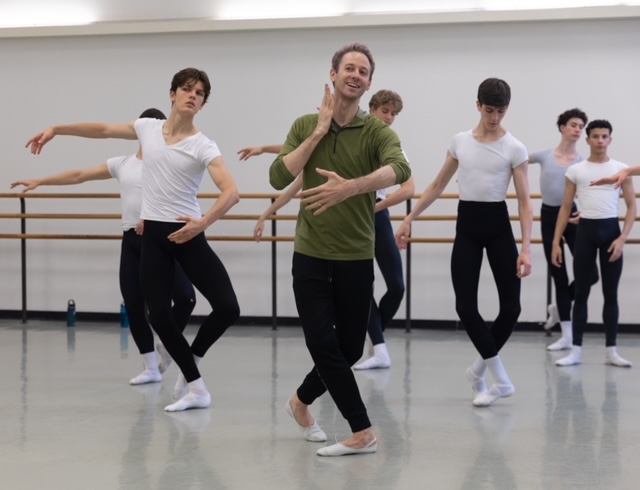
Most anyone in dance education has experienced those uncomfortable moments when a student responds negatively to feedback, refuses to apply corrections, or outright talks back.
While most teachers generously share their knowledge in hopes of bettering a student’s practice, it doesn’t mean dancers will always be agreeable or receptive.
As the cultural landscape of dance matures, there is a sincere push for younger individuals to better advocate for themselves. Setting healthy boundaries, like speaking up for one’s physical and mental health, having a say in hands-on corrections, or asking questions regarding practices, is becoming commonplace. And while it is good for students to have a say in their training, there are still times when pushback may disrupt the power dynamics within a classroom and halt learning altogether.

Ideally, students will trust their teachers have the best intentions in mind for them and respond accordingly. But if this isn’t happening, how does one create a healthy, pushback-free learning environment?
What Causes Pushback?
Schools may have different dynamics based on culture, location, and access to alternative types of training. Looking to larger, more established programs, which commonly accept students after their introduction to dance, may offer insight as to why some schools or teachers have more pushback than others.
As senior faculty at the School of American Ballet, Andrew Scordato notes: “I teach in a place where most kids have already decided they want to pursue a career in dance. While many start with us, others come here to continue and finish their training. Due to this dynamic, dancers tend to show up with a different understanding of training than a student who is newer to dance.”
In reality, many recreational, competition, and open-class programs are not only responsible for instilling early technique and passion for dance, they are also a student’s first introduction to classroom etiquette, understanding the requisite commitment to training, and general dance culture. These localized programs may introduce foreign concepts to their students, which may cause stress and resistance.
Set Expectations Early On
More likely than not, negative reactions from students derive from a lack of understanding regarding classroom rules, poor communication, or unclear expectations.
According to Melanie Person, The Ailey School, where she is co-director, holds orientations for all new students. “When dancers come to us, we inform them what they signed up for. We discuss our curriculum and the techniques they will learn, the number of weekly classes, dress code, and much more. We give as much information as we can up front, so they know what to expect. It is also important they understand their training goes two ways. We endeavor for it to be satisfying for both the dancer and our institution.”
While the structure of leadership at programs may differ vastly between local schools and larger institutions, clarity of expectations is integral to all studio cultures. Creating a shareable document of guidelines and expectations, then discussing the most important aspects of this policy in a meeting, may be the greatest tool in preventing issues in the classroom.
Don’t Take It Personally
Even at the most well-informed schools, there is always the possibility that a student will respond to a teacher in an unexpectedly negative way. Being on the receiving end of pushback, it may come off as if the student is upset with their teacher. But this isn’t always the case.
Lindsi Dec, co-owner and co-director of DeCruz Ballet, does her best not to assume the root of a dancer’s emotions. “When a student has a moment, I also take a moment to check in and see what’s actually going on. Maybe they’re stressed about something outside of ballet. I don’t take their energy personally because it likely has nothing to do with me. I’ve learned to be more understanding and receptive to my students, helping guide them through the intricacies of these conversations and letting them know they do have a voice.”

Keep the Conversation Going Outside Class
Once expectations are set and dancers find their flow in classes, it is important to maintain clear pathways for communication.
At The Ailey School, Person shares, all students in the Professional Division have their own advisor. “Students have regular meetings where their progress is discussed and they may share concerns regarding teachers or other items.” Additionally, students can schedule an appointment directly with Person at any time.
At Dec’s boutique program, she feels her students thrive having easy access to communicate directly with her and her co-director husband. “Our kids email us about practically anything. Whether talking in the studio or a simple email, we take time to respond directly. If they are willing to ask difficult questions about their future, we want to support them.” Dec also mentors parents on how best to support their children. “We try to eliminate stressors for parents, which if not taken care of may also place stress on the kids.”

Train the Individual, Not the Group
While a great deal of training is done in group settings, it is often the individual experience that makes a dancer feel both comfortable and safe enough to be receptive in the classroom.
Sharing his individual-focused approach, Scordato says: “It’s integral to understand that neurodiversity exists and each student is different. While dancers may be in class together, I treat them individually. You have to tailor training differently for each student while teaching the class as a whole. I am mindful of more democratic approaches and adjust my practice to the dancer in front of me.”
When it is assumed all dancers learn the same way and share equal levels of comfort in a learning environment, some will thrive while others may feel diminished. With clear expectations and straightforward pathways of communication, fewer roadblocks should stand in the way of trusting the training process. But the final key to preventing pushback is to ensure that each individual feels understood and that their needs are respected.
Editor’s note: The title of this article was updated on 03.20.24 to better suit its content. Thank you for your feedback!





